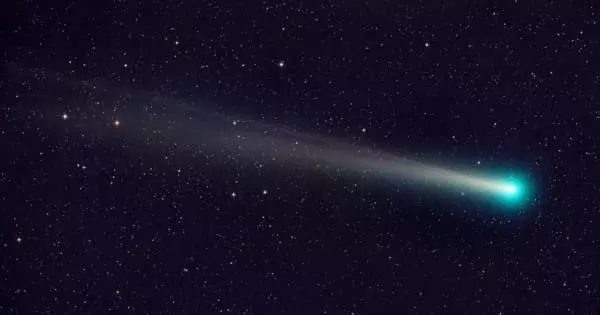Astronomers have discovered that comet Bernardinelli-Bernstein (BB), the largest comet ever discovered, was active much earlier than previously thought, implying that the ice within it is vaporizing and forming dust and vapor envelope known as a coma. Only one other active comet has been observed farther away from the sun, and it was much smaller than comet BB.
A new study by astronomers at the University of Maryland reveals that comet Bernardinelli-Bernstein (BB), the largest comet ever discovered, was active much earlier than previously thought, implying that the ice within it is vaporizing and forming an envelope of dust and vapor known as a coma. Only one other active comet has been observed farther away from the sun, and it was much smaller than comet BB.
The discovery will aid astronomers in determining what BB is made of and will shed light on the conditions that existed during the formation of our solar system. The discovery was made public in The Planetary Science Journal.
The size of comet BB and its distance from the sun indicate that carbon monoxide dominates the vaporizing ice that forms the coma. These observations push the distances for active comets dramatically farther than we previously knew.
Tony Farnham
“These observations push the distances for active comets dramatically farther than we previously knew,” said Tony Farnham, lead author of the study and a research scientist in the UMD Department of Astronomy.
Understanding what a comet is made of requires knowing when it becomes active. Comets, also known as “dirty snowballs” or “icy dirtballs,” are clumps of dust and ice left over from the formation of the solar system. As an orbiting comet gets closer to the sun, it warms up and the ices begin to vaporize. The temperature required to begin vaporization is determined by the type of ice present (e.g., water, carbon dioxide, carbon monoxide or some other frozen compound).
Comet BB was discovered in June 2021 using data from the Dark Energy Survey, a collaborative international effort to survey the Southern hemisphere’s sky. The survey captured the comet’s bright nucleus but lacked the resolution to reveal the envelope of dust and vapor that forms when the comet becomes active.

Comet BB is by far the largest comet ever discovered, measuring 100 km in diameter and orbiting the sun farther away than the planet Uranus. When discovered, most comets are about 1 km in size and much closer to the sun. When Farnham learned of the discovery, he wondered if images of comet BB had been captured by the Transient Exoplanet Survey Satellite (TESS), which observes one area of the sky for 28 days at a time. He reasoned that the longer exposure times of TESS could provide more detail.
Farnham and his colleagues combined thousands of images of comet BB taken by TESS between 2018 and 2020. Farnham was able to increase the contrast and get a better view of the comet by stacking the images. However, because comets move, he had to layer the images to ensure that comet BB was precisely aligned in each frame. This technique removed errant specks from individual shots while amplifying the image of the comet, allowing researchers to see the hazy glow of dust surrounding BB, proving that BB was in a coma and active.
To ensure that the coma wasn’t just a blur caused by image stacking, the researchers repeated the technique with images of inactive objects from the Kuiper belt, a region much farther from the sun than comet BB that is rich in icy debris from the early solar system. Researchers were convinced that the faint glow surrounding comet BB was an active coma when those objects appeared sharp and without blur.
The size of comet BB and its distance from the sun indicate that carbon monoxide dominates the vaporizing ice that forms the coma. Because carbon monoxide can begin to vaporize up to five times farther away from the sun than comet BB was when it was discovered, BB was most likely active long before it was discovered.
“We assume that comet BB was probably active even further out, but we just didn’t see it before this,” Farnham explained. “What we don’t know yet is if there’s a point at which we can start to see these things in cold storage before they become active.”
Farnham believes that the ability to observe processes such as the formation of a cometary coma from a greater distance than ever before opens up an exciting new frontier for astronomers. “This is only the beginning,” Farnham explained. “TESS is observing phenomena that have not yet been discovered, and this is a kind of test case for what we will be able to discover. We have the potential to do this a lot once a comet is discovered, going back in time in the images and finding them when they are farther away from the sun.”





